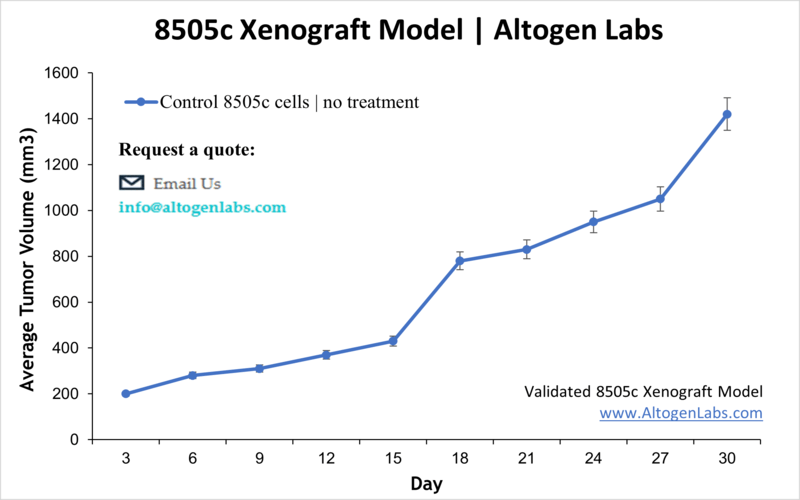
8505C Xenograft Model
The thyroid is a hormone-secreting endocrine gland located in the neck; thyroid cancer is often asymptomatic but signs may include a neck lump or swelling. Risk factors include radiation, genetics or other environmental factors. Thyroid cancer can be diagnosed with ultrasound or fine needle aspiration. There are four main thyroid cancer types: papillary, follicular, medullary and anaplastic. The 8505c cell line is from the primary cancer tissue of a 78 year old female patient with thyroid cancer. 8505c cells are undifferentiated and anaplastic in morphology. Parts of the primary tumor was pathologically differentiated, which suggests that the cancer had a progression towards undifferentiated. The 8505c model has been used in many thyroid cancer studies. In 2009, Nucera et al. published an article in Thyroid using the 8505c cell line to establish an orthotopic model of human melanoma in immunodeficient mice. Their results demonstrated high-grade neoplasms as a result with necrosis, p53 positivity, anaplasia, high proliferative and mitotic indexes, distant and lymph node metastases and extrathyroidal invasion). This is the first study to establish 8505c cells as a metastatic xenograft model. The 2014 Thyroid article (Zhang et al.) used many anaplastic and follicular cell lines to identify metastatic models with detectable metastases sites using in vivo imaging. They found that xenograft models established with THJ-16T-Luc2, C-643-Luc2, FTC-133-Luc2, FTC-238-Luc2, FTC-236-Luc2, and XTC-1-Luc2 were the most easily detectable and that 8505C lung metastases in xenografts responded to vemurafenib treatment and is suitable for metastatic and functional thyroid cancer studies. Finally, Lin et al. (Oncotarget, 2017) used 8505c as a model of anaplastic thyroid cancer to study the effects of roniciclib, an inhibitor of cyclin-dependent kinase. Results demonstrated roniciclib-induced apoptosis (caspase-3 activity) and cell cycle inhibition as well as in vivo growth inhibition in xenograft models. The 8505c cell line is used to create the CDX (Cell Line Derived Xenograft) 8505c xenograft mouse model. The 8505c xenograft model is used in thyroid cancer studies (microRNA expressions, pluripotency markers, MED inhibition, metastatic studies, vemurafenib, roniciclib).
Basic Study Design
- The 8505C cells are maintained in exponential growth phase under aseptic conditions.
- Cells are trypsinized and cell count viability is determined using a trypan blue exclusion assay (98% of cell viability is required). 8505C cell suspension is adjusted to appropriate density.
- Each mouse is singly subcutaneously injected into the right flank with 106 cells in 100-200 µL of a Matrigel-8505C cell suspension.
- The injection sites are palpated up to three times weekly until tumors are established to an average size of 75-150 mm3 as measured via digital calipers.
- Animals are randomized into treatment groups. Administration of test compound is performed according to the pre-established treatment schedule.
- Mice weights are measured and recorded 2-3 times weekly; tumors are measured and recorded daily.
- End of study is reached when tumor size reaches 2,000 mm3 or the predetermined size limit per approved IACUC protocol.
- Final necropsy and tissue collections are performed for appropriate downstream analysis. Tumors are excised, weighed and documented by digital imaging. Tumors and tissues can be stabilized in RNAlater, snap frozen in LN2 or prepared for histology.
